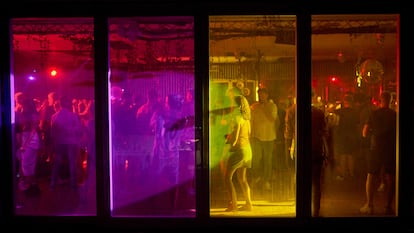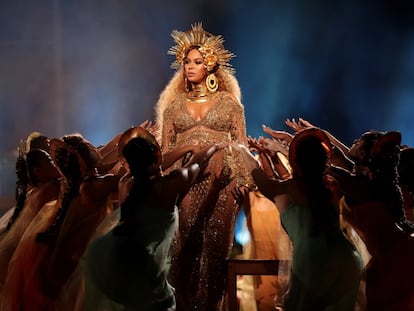Over a billion young people may be at risk of hearing loss from headphones and loud venues
A study estimates that 24% of teenagers who use personal listening devices and nearly half of those who go to nightclubs and other entertainment locales are vulnerable due to unsafe listening practices

A quiet conversation in a library is about 25 decibels. The sound of traffic on a noisy street reaches 50 to 60 decibels. The noise at a nightclub and the sound of a drill can top 100 decibels. The scientific community says that any prolonged exposure to sound above 80 decibels begins to put hearing health at risk, whether in the short, medium or long term. Hearing suffers and is damaged. A scientific review published in the British Medical Journal Global Health estimates that between 670 million and 1.35 billion teenagers and young adults around the world are at risk of hearing loss from unsafe listening practices. Specifically, 23.8% of young people who use personal listening devices at high intensity, such as loud music through headphones, and almost half of those who go to noisy entertainment venues, such as bars and nightclubs, are at risk of some form of hearing damage. Experts warn of “the urgent need” to promote safe listening habits.
Damage to hearing health is influenced by noise intensity and exposure time. According to a World Health Organization (WHO) report, when using portable audio devices to listen to music for 15 minutes at 100 decibels, people are exposed to the same sound level as an industrial worker experiences in an eight-hour workday at 85 decibels. Because the typical listener’s volume limits are between 75 and 105 decibels, the WHO says, these levels are “cause for concern.”
Intensity and exposure time go hand in hand. While susceptibility thresholds vary from person to person, being exposed to high decibels over a long period of time takes a toll on hearing health. Specifically, the cochlea, a snail-shaped organ in the inner ear, is most impacted by the effects of noise: the cochlear hair cells, which transmit information to the brain through the auditory nerve, suffer from this exposure and manifest the damage through tinnitus (an intense ringing in the ear), for example. The WHO estimates that more than 430 million people worldwide have disabling hearing loss; that figure may double if investment in prevention mechanisms does not occur, the organization says.
The authors of the study defined unsafe listening practices as those exceeding 80 decibels for 40 hours a week. The researchers focused on two risk phenomena: the use of personal listening devices, such as cellphones and music players with headphones, and attendance at noisy entertainment venues, such as discos, bars and clubs. Scientists reviewed the evidence available since the turn of the century in four languages and collated some 30 studies from which they were able to recalculate the prevalence of young people engaged in risky listening practices.
After analyzing the sample studies and considering that, in 2022, there are 2.8 billion people between the ages of 12 and 34 years old, the scientists concluded that between 670 million and 1.35 billion people around the world “may be at risk of hearing loss due to voluntary unsafe recreational listening practices.” As Lauren Dillard, the author of the study and a postdoctoral researcher at the University of South Carolina, explains, “If people are exposed to loud sounds, sensory cells and other structures in the ear can become fatigued and eventually damaged. Fatigue of the sensory cells often results in tinnitus and/or temporary hearing loss. If people are regularly exposed to loud or prolonged sounds, this damage can become permanent, which can lead to irreversible hearing loss, tinnitus, or both.”
The researchers consider these prevalence figures to be “high,” although they admit that it is a “rough” estimate. They acknowledge that the heterogeneity of the studies included in the review and “the lack of a standardized research methodology” are limitations of their study. For example, the authors did not include studies of low-income countries, so it is possible that the overall burden “does not capture unsafe listening practices” there, they note. Furthermore, they recognize that there are also likely “demographic and personal differences” in hazard perception and risk behaviors.
While the range in prevalence of these unsafe listening practices is quite wide, it does not differ much from what the scientific community already knew, says Luis Lassaletta, president of the Otology Commission of the Spanish Society of Otolaryngology. “It is difficult to give an estimate, but [the study] coincides with what we think. This study is very useful for raising awareness about the risks of noise,” avers Lassaletta, who was not involved in the research. The WHO estimates that over 50% of people between the ages of 12 and 35 listen to music through their personal audio devices at a volume that puts their hearing at risk.
Hearing loss and tinnitus
In practice, the damage can translate into temporary hearing loss or acute tinnitus (a constant ringing or buzzing in the ear). Moreover, in the long term, exposure early in life can make people more vulnerable to age-related hearing loss. In children, scientists remind us, hearing loss leads to reduced school performance, motivation and concentration. In adults, the implications of hearing impairment range from a decline in psychosocial well-being to an increased risk of serious ailments, such as cognitive impairment.
The BMJ Global Health research also warns of so-called “hidden hearing loss,” or cochlear synaptopathy, which is a precursor to cochlear hair cell damage. “These are people exposed to noise who, without having actual damage to the hair cells, have previous problems in the connection between these cells and the auditory nerve,” explains Lassaletta. He adds that such damage would not be seen through traditional audiometry; only audiometry performed under noise conditions could detect it.
The study’s authors admit that their scientific conclusions about the extent of the health impact of these listening practices vary. In fact, they note, “the evidence showing consistent associations between adolescent exposure to recreational noise and permanent hearing loss is sparse.” However, Dillard cautions that experimental studies have found “physiological damage to the auditory system” after exposure to high-volume noise. She explains that “immediately following exposure to loud sounds, signs of temporary damage, including tinnitus and changes in hearing, may appear, but resolve within a few days. However, there is also some evidence that continued exposure to loud noise can cause permanent damage over a lifetime…This can be difficult to measure because changes in hearing are often progressive and incremental;…it can be difficult to notice changes in hearing over long periods of time.”
Whether permanent or temporary, the damage exists nonetheless, say outside experts consulted by this newspaper. “We are seeing the advance of the age of presbycusis [progressive hearing loss],” Lassaletta observes. This damage, along with uncomfortable tinnitus, impacts more than auditory health. “There is a greater risk of poor mental health, and there are even associations with the risk of ischemic heart disease. Tinnitus is very common, but those who have it persistently sometimes need psychological support because of its effects,” he adds.
“Trivialization and derision”
Physicians lament the “trivialization and derision” of hearing problems and advocate implementing additional social awareness measures. The study’s authors urge enacting policies to encourage safe listening habits and change individual behaviors. For example, Switzerland has a regulation on sound in recreational spaces and venues, which are required to limit average hourly sound levels to 100 decibels and provide free earplugs, among other measures. Experts also encourage people to modify their own listening habits. “Monitor the listening levels in your device settings, and if it tells you that you are at unsafe levels, turn down the volume. Consider using headphones that reduce background noise, as this will help you listen at lower, safer levels because you won’t need to turn up the volume to drown out background noise. If your ears ring or you find it hard to hear after listening to music with headphones or attending a concert, that’s a sign that the music is too loud,” advises Dillard.
As a general rule, Lassaletta points out that “the recommendation is not to use the device for more than 60 minutes at more than 60% of its intensity.” He encourages lowering the volume of music when using headphones - “if you recognize the song of the person next to you in the subway, that person has it too loud,” he says - and protecting your ears at concerts.
Lassaletta adds that it is important to reveal hearing problems and the effects of long-term exposure to high noise levels, as well as to not feel ashamed of doing so. Increasingly, he says, celebrities are going public about their hearing issues. For example, AC/DC singer Brian Johnson suffers from tinnitus, an ailment that has forced him to cancel concerts. In 2015, the singer and guitarist of the Spanish ska-punk band SKA-P, Pulpul, explained that uncontrollable tinnitus has kept him away from the stage: “I hope you can understand me. I’ve been silent for over 20 years, and the worst thing is that the army of crickets grows in number as time goes by. I know that many musicians suffer from tinnitus, and [we] go on because our life without music is an empty life, but I did the same, and it has gotten worse. Be very careful; protect your ears as much as you can.”
Tu suscripción se está usando en otro dispositivo
¿Quieres añadir otro usuario a tu suscripción?
Si continúas leyendo en este dispositivo, no se podrá leer en el otro.
FlechaTu suscripción se está usando en otro dispositivo y solo puedes acceder a EL PAÍS desde un dispositivo a la vez.
Si quieres compartir tu cuenta, cambia tu suscripción a la modalidad Premium, así podrás añadir otro usuario. Cada uno accederá con su propia cuenta de email, lo que os permitirá personalizar vuestra experiencia en EL PAÍS.
¿Tienes una suscripción de empresa? Accede aquí para contratar más cuentas.
En el caso de no saber quién está usando tu cuenta, te recomendamos cambiar tu contraseña aquí.
Si decides continuar compartiendo tu cuenta, este mensaje se mostrará en tu dispositivo y en el de la otra persona que está usando tu cuenta de forma indefinida, afectando a tu experiencia de lectura. Puedes consultar aquí los términos y condiciones de la suscripción digital.
More information
Últimas noticias
Most viewed
- Sinaloa Cartel war is taking its toll on Los Chapitos
- Oona Chaplin: ‘I told James Cameron that I was living in a treehouse and starting a permaculture project with a friend’
- Reinhard Genzel, Nobel laureate in physics: ‘One-minute videos will never give you the truth’
- Why the price of coffee has skyrocketed: from Brazilian plantations to specialty coffee houses
- Silver prices are going crazy: This is what’s fueling the rally











































